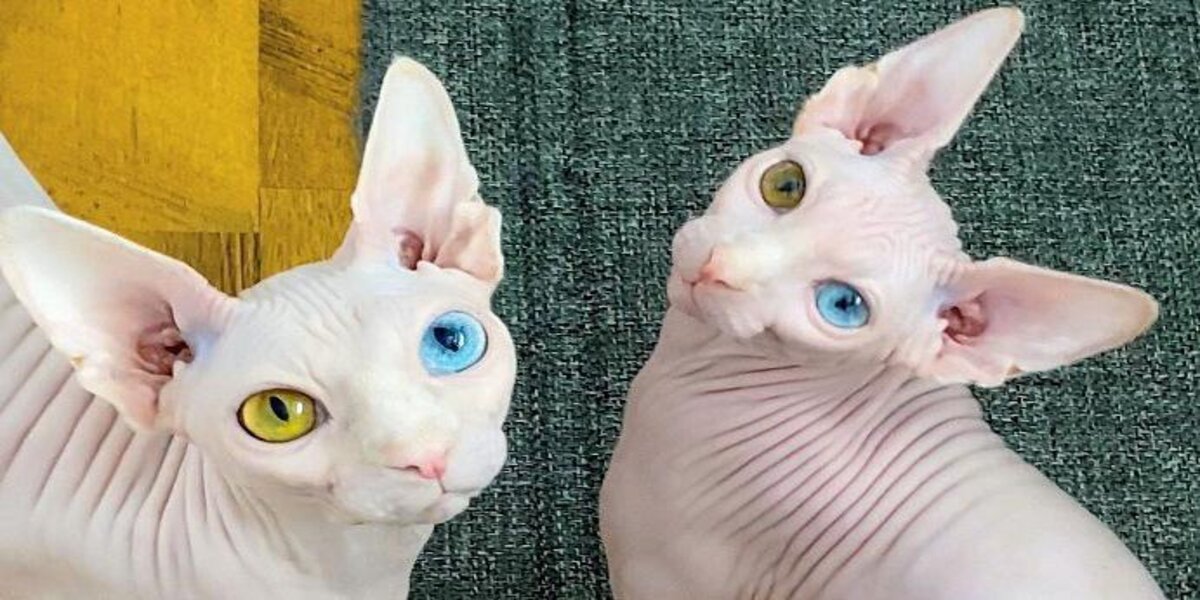Table of Contents
The Sphinx is a medium sized cat with a very striking appearance due to its lack of fur, wrinkled skin and long ears. It has a smooth, muscular body that is very compact and heavy for its size.
Sphinx cat: a medium-sized but well-muscled breed
Its head is triangular with wide-set eyes and prominent cheekbones, reminiscent of ancient Egyptian cats, hence its name. In addition to being hairless, the sphinx’s most notable feature is its long, triangular ears, reminiscent of bats.
Although the sphinx appears completely bald at first glance, closer inspection will reveal very fine, short hair that gives the skin the appearance of very fine suede.
The absence of hair is what marks a sphinx in the first place with the color and pattern remaining in the pigmentation of the skin. Colors and markings may vary slightly and these cats can exhibit virtually any color or pattern, including solid color, tortoiseshell or brindle.
Personality
The sphinx cat is an energetic and acrobatic performer who loves to attract attention. He has an unexpected sense of humor that does not match his serious expression.
Friendly and affectionate, it is a loyal breed that will follow you around the house trying to participate in everything you do, taking every opportunity to climb on your shoulder or curl up on your lap.
As curious and intelligent as he is energetic, characteristics that mean he can be a bit untamed. For its own safety, the Sphinx is a cat that is best kept outdoors and gets along well with other pets and children.
Coexistence
The Sphinx breed is a strong, heavy breed with some health issues. Despite having no genetic predisposition, certain health conditions are known to affect sphinxes such as hypertrophic cardiomyopathy, which is a disease that causes engorgement of the heart muscle and can be detected with an echocardiogram, and hereditary myopathy, a disease that affects heart function, Vetstreet says.
Sphinxes are also often prone to skin problems such as urticaria pigmentosa, which causes very painful sores all over the body. This breed is also predisposed to periodontal disease, so regular and thorough oral hygiene (both brushing and veterinary checkups) should be maintained.
When adopting a sphinx cat, avoid breeders who refuse to offer you a health guarantee for the kittens or who state that their lines are guaranteed free of hypertrophic cardiomyopathy.
Although this condition is not hereditary, it is a very common form of heart disease in cats and no breeder can guarantee with absolute certainty that a cat will not develop this disease.
It is an active breed that enjoys jumping, playing and climbing as much as any other cat scratching. They should have scratching posts as well as places to climb and rest.
Despite their lack of fur, the Sphinx is not considered a hypoallergenic breed because their skin produces normal amounts of allergens.
History
Originally named the Canadian Hairless Cat, the sphinx got its start in Toronto, Canada, in 1966 when a litter of domestic shorthair kittens gave birth to a hairless kitten as a result of a naturally occurring genetic mutation.
Although other hairless cats had been born previously, the Sphinx as we know it today is the result of selective breeding of these hairless cats from normal litters.
This process did not result in the desired breed characteristics, but served to expand the gene “pool” that made it possible to produce a genetically independent cat breed, according to Cattime.





